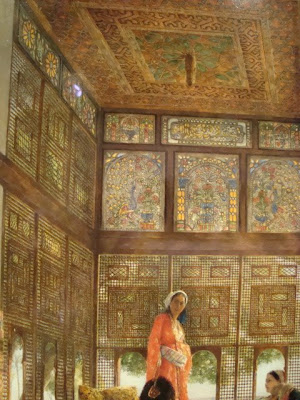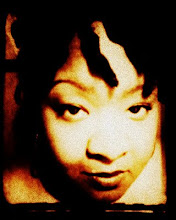

Since I've already visited Yale Art I'll only talk about a few things I enjoyed there.... Like the center for British Art, across the street, Yale Art is a modern building. It has, throughout, a concrete coffered ceiling and black marble tile floors, and low lighting with respect to the actual art which has spotlights. And unlike the other gallery, it has floating, colored walls in each gallery that seem to reflect colors that would be found in the culture of the exhibits. For example in the Asian Arts wing some of the walls are painted a rich navy blue, taupe, and a particular shade of red, where as in the modern collection the walls are a light gray and/or white, the early European secton is signified by it's wine colored walls.
I started, again on the top floor which is the Picasso exhibit that I loved. There were drawings, paintings, illustration and sculptures. I figured out, after looking at a photo of Picasso, that most of his figures share the same profile as him. It's an interesting group of things here, set in a Red and Teal walled room. In between the gallery was a little walkway with a collection of poems and text collaged onto small paintings, illustrations and some sketches. He did a small postcard sized drawing of just faces which I enjoyed so much that I bought the postcard. I also really loved this simple drawing Head of a Woman, which is the subject of numerous pieces, but this one is done in gouache and ink, there's nothing spectacular about it but it is one of my favorites in this collection, along with a painted steel sculpture of the same subject.




On to the 3rd floor for the Early European and modern collection. Now because I just came from the British Center, I decided not to spend any real time in the Early European collection. I did however notice how some of the early European religious paintings which are very close in imaging to the Ethiopian christian art and some of the other earlier paintings gave me a feeling of surrealism. Other than that I didn't really care to re-examine anything that I haven't seen before. I think it would have been overkill, but it is a very nice gallery.
On the other side of the 3rd floor gallery is the permanent modern collection. In it I was pulled in by a Stuart Davis oil painting titled Combination Concrete #3, which I read is an ode to Jazz. And I can clearly see that in the way Davis positions his figures and the colors. It has so much movement. The yellows pop and retract, the black contrasts the white, the white contrasts the blue, it's doing so much. You can stand in front of it for quite some time just trying to figure out where he started. I've had to do a Stuart Davis like painting for a class and it was a fraction of the size and still very complicated, so I can only imagine how much work was put into this almost 5 x 3 ft painting. It's a seemless collage of color and shapes.

Across the hall on the same floor was another visiting exhibit of modern art. Again white and light gray floating walls, light wood flooring infused with concrete structure. Here, in this hall, were a few wonderful and disturbing things. What caught my eye immediately was a man sitting on the floor, sleeping. What I didn't realize is that it was a figure, a drug addict. It was so ridiculously realistic, and just the thought of him there, overdosing, bothered me. Also there was another piece title the unborn. A very gray abstract, very textured. On it were little silver-ish lab jackets that were sometime filled with or had a trail of a plaster looking substance (an unformed fetus?) and numbered to signify the unborn, and again the idea of them were disturbing. Moving on from these pieces another strange but interesting piece, a sculpture, caught my eye. It was a pure white alien looking figure by Alberto Giacometti called Hands Holding the Void. I really liked this piece. It put me in the mind of a science fiction flick, something where they would have frozen the alien in the middle of his actions. The expression on his face seemed as if he lost something and he was also devoid of color and life, the title was very fitting. Backtracking.... I didn't however understand an exhibit of a hanging shovel on the other side of the gallery. But they were mostly pretty intersting stuff where in most you can see the connection and others leave you lost. Another one to see here is the Basquiat, just because he's one of my favorite artists.

On the Second floor are the Asian and African art galleries. Lots of wonderful masks, pottery, tapestries, armor, carvings, etc. In the African wing there is this beautifully beaded piece of a bird, it is so vibrant and intricate. The set up is very simply laid, here though are plum, gray and moss colored focus walls, which are very earthy tones, like those that may be found in Africa. There is also a nice center exhibit of a headdress set against enlarged photos of a ceremony. It was heavy looking and meant to wear over the shoulders. Across the hall is the Asian exhibit, again here there are colorful focus walls. I love Asian art so I spent a little more time here, and I've grown up with alot of African art much like that which was in this gallery with the acception of some of the pieces. But in the Asian wing were some beautiful pottery, scrolls and statues. An enchanting display of war armor which was seating and staring right at you. Here I found a little ivory carving amongst a few others, it wasn't the smallest carving of the bunch, but the most interesting.

The closing of my visit was with the Japanese Tea Culture exhibit. A intimate collection equipped with its own recreated tea room. The focus here was of all of the little intricacies that go into a Japanese Tea experience, the small cups and kettle, bamboo flooring, simple setting, candles and Kimonos; one of which they had and it was so beautifully quilted.Overall this was a great way to spend my three hours ( between the 2 museums). I really gave myself to the exhibits this time and it was worth it.












































